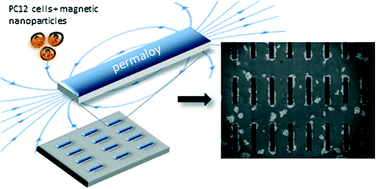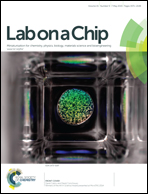Magnetic micro-device for manipulating PC12 cell migration and organization†
Abstract
Directing neuronal migration and growth has an important impact on potential post traumatic therapies. Magnetic manipulation is an advantageous method for remotely guiding cells. In the present study, we have generated highly localized magnetic fields with controllable magnetic flux densities to manipulate neuron-like cell migration and organization at the microscale level. We designed and fabricated a unique miniaturized magnetic device composed of an array of rectangular ferromagnetic bars made of permalloy (Ni80Fe20), sputter-deposited onto glass substrates. The asymmetric shape of the magnets enables one to design a magnetic landscape with high flux densities at the poles. Iron oxide nanoparticles were introduced into PC12 cells, making the cells magnetically sensitive. First, we manipulated the cells by applying an external magnetic field. The magnetic force was strong enough to direct PC12 cell migration in culture. Based on time lapse observations, we analysed the movement of the cells and estimated the amount of MNPs per cell. We plated the uploaded cells on the micro-patterned magnetic device. The cells migrated towards the high magnetic flux zones and aggregated at the edges of the patterned magnets, corroborating that the cells with magnetic nanoparticles are indeed affected by the micro-magnets and attracted to the bars' magnetic poles. Our study presents an emerging method for the generation of pre-programmed magnetic micro-‘hot spots’ to locate and direct cellular growth, setting the stage for implanted magnetic devices.

- This article is part of the themed collection: Implantable Devices

 Please wait while we load your content...
Please wait while we load your content...